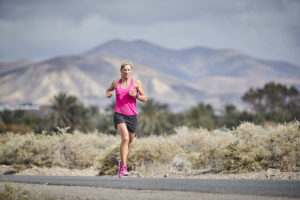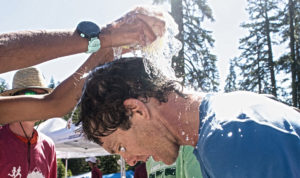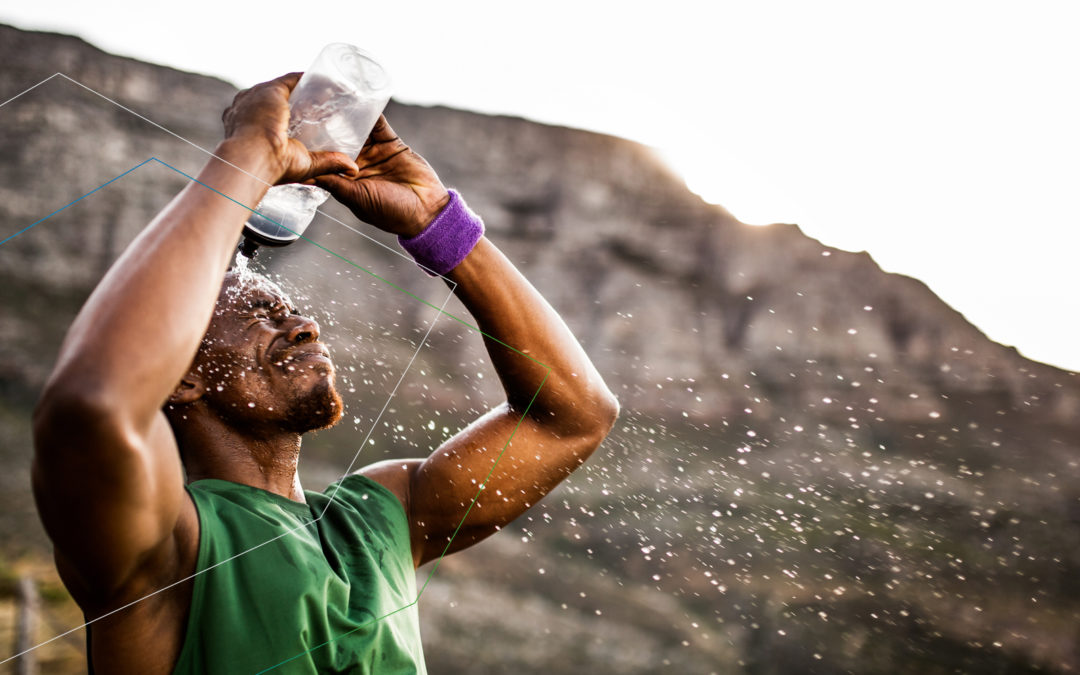Heat risk all athletes face
The Centers for Disease Control and Prevention reports that heat illness during a sports activity has been and continues to be a leading cause of death among athletes in extreme heat conditions.
The body temperature is more than just a safety issue for athletes, however. It also affects performance.
Exercise produces heat, requiring energy to help maintain a stable core body temperature. What would happen if athletes took on some of the burden of managing the internal temperature of their bodies? It would free up energy for other needs, like performance. That is the basis behind thermoregulation tools and interventions used in athletics.
What is Thermoregulation?
Thermoregulation is the body’s natural cooling system. Central nervous system sensors measure the body temperature and send a signal to the hypothalamus if it changes. The hypothalamus activates hormones and body mechanisms designed to bring the core temperature back into check. This is what keeps organisms like human beings at homeostasis, or at a stable core temperature, regardless of the environment. Whether it is 35° or 120° outside, your body strives to maintain a core temperature close to 98.6° Fahrenheit.

Thermoregulation works within a very narrow window. Any shift in temperature can cause a physical reaction. When you sit in a hot car, your temperature rises just a couple degrees before you start sweating. That is the body’s attempt to bring your temperature back down. Conversely, if you go out into the cold and your temperature drops a degree or two, you begin to shiver. This movement generates energy that warms you back up. The shivering stops when you are once again in a state of homeostasis.
Thermoregulation During Sports Activities
The extreme exercise required during athletics introduces challenges to thermoregulation. The body initiates physiological mechanisms in an attempt to prevent an excessive rise in core temperature. There are four processes involved in thermoregulation.
- Radiation: The transfer of heat by electromagnetic waves
- Convection: Air movement
- Conduction: Physical contact
- Evaporation: Sweating

If the outside temperature and humidity are high, this makes the task of keeping cool more daunting, because three out of four of the mechanisms used to regulate body temperature become ineffective. External temperature interferes with the heat exchange between the body and the environment, so radiation, convection and conduction fail first. All that is left is evaporation. The higher the core temperature becomes, the more fluid an athlete loses through the skin.
How Thermoregulation Affects Athletic Performance
Copious sweating takes a heavy toll on a body already challenged by physical exercise. Marathon runners lose up to six liters of water through their skin during a race. Someone playing a field game like football or soccer may lose two liters per hour on a hot day. Without adding fluids, channeling existing body fluids to the skin to lower temperature puts stress on the circulatory system. The heart works harder to accommodate the fuel requirement of muscle movement and the need to reduce body heat.
Heat stress causes fatigue and fatigue lowers or stops performance. The more energy an athlete puts into keeping his or her body temperature at a safe level, the less is available for muscle movement, so endurance fails, as well. By finding ways to acclimatize during an activity, you keep your body temperature at an optimal level to enhance performance.
The Dangers of Poor Thermoregulation
The death of Stringer and others makes it all too clear how critical maintaining body temperature is for athletes. Exertional heat illness and stroke are treatable conditions if caught early. The problem is that athletes don’t often recognize the signs, because their focus is on performance. Many of the symptoms of heat illness mimic that of exercise fatigue, as well. Athletes are taught to push through the pain so many don’t understand the danger they face as their body temperature rises.
Athletes can go down even on cool days if they are improperly dressed or fail to take precautions. A well-rested and hydrated athlete has a better chance of controlling body temperature during extreme exercise.
Intervention Strategies That Give Athletes an Edge
Poor thermoregulation is detrimental to performance, but, the good news is, it is also fully preventable. With programs like the Heat Safety Pledge, athletes are learning intervention strategies that regulate body temperature during exercise and improve performance.
It starts with education, both for athletes and coaches. There are steps they can take to prevent overheating during a game or race.
Don’t rely on your judgment when it comes to hydration. One simple indicator is urine color. The color of urine indicates whether an athlete is adequately hydrated prior to a workout or event. Lighter colors generally mean better hydration. Urine color charts are available to help gauge fluid intake.
Continue to hydrate throughout the practice. Proper hydration prevents increases in core body temperature during extreme exercise. For every 1 percent of body mass lost via sweat, the body temperature rises by .5 degrees Fahrenheit. Rehydration helps an athlete maintain intensity level.
Weighing in before exercise is another practical measuring tool. The Korey Stringer Institute states that athletes should not lose more than 2% of their body weight during a practice or event. Taking a weight measurement prior to each practice ensures the athlete starts out in good condition. There should be little reduction in weight between daily practices.
Coaches must learn first aid, cardiopulmonary resuscitation and how to use an automated external defibrillator (AED) in case of an emergency. Coaches can get certified through the National Federation of High School Association.
Athletes must know how to recognize signs of heat illness in themselves and their teammates, as well. This includes:
- Irrational behavior
- Dizziness or disorientation
- Headache
- Nausea
- Diarrhea
- Muscle cramps
- Staggering
- Profuse sweating
- Poor performance
- Dry mouth
- Rapid pulse
Sudden cessation of sweating is a sign of impending heat stroke. If you are sweating profusely and stop, then you need to cool down immediately.
Acclimatization to Enhance Performance
The smart athlete understands the connection between body temperature, environment and performance. Learning to acclimate to the environment is how you maximize thermoregulation to get a competitive edge.
Through heat acclimation, the body has time to adjust to a new external temperature in a controlled way. Preparation means that during extreme exercise, the climate becomes less of a factor. This positive approach to training gives an athlete more control over performance.
The University of Connecticut offers steps you can take to improve your performance through body acclimatization.
- Practice once a day in the first five days in a new climate
- Avoid practicing more than three hours a day
- Wear light gear until day six of practice, then you can switch to full gear if needed
- Avoid full-contact drills until day six
- Follow days with multiple practices with a single practice day or a rest day
- Increase the intensity of your practice slowly over a few days
- Increase the sodium in your diet for the first few days. Sodium helps the body retain the fluid necessary for temperature regulation.
- Keep cooling stations stocked with ice towels and tubs during practice
- Take plenty of breaks to allow the body to cool down
If you are an athlete looking for ways to better your fitness level and enhance your performance, consider what thermoregulation can do for your game. Your body uses energy to maintain its core temperature. You take control when you make the effort to stabilize that temperature during your game. Thermoregulation allows you to preserve your optimal body temperature, so you deliver the best performance and stay safe at the same time.
A true love for sports


Recent Comments